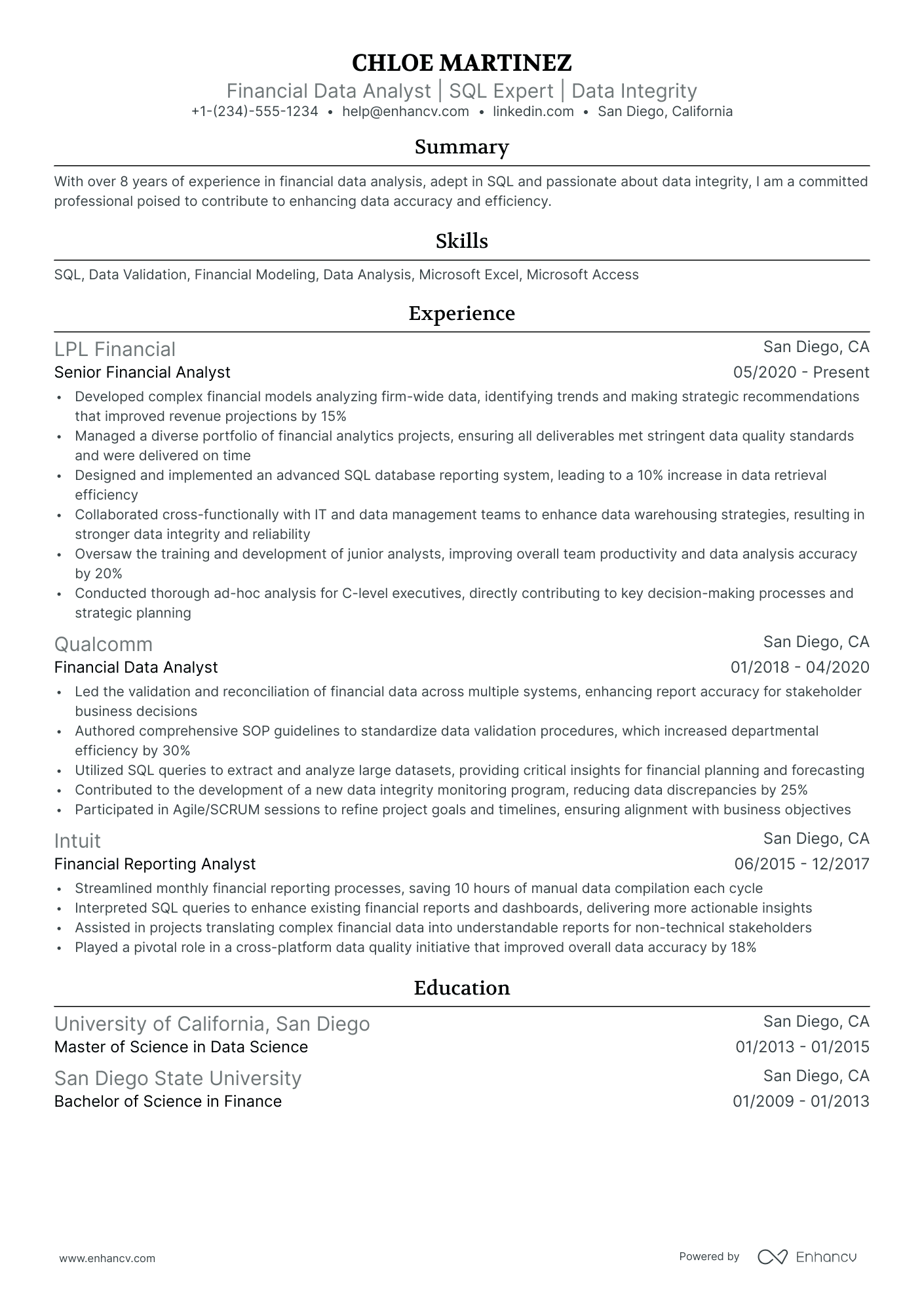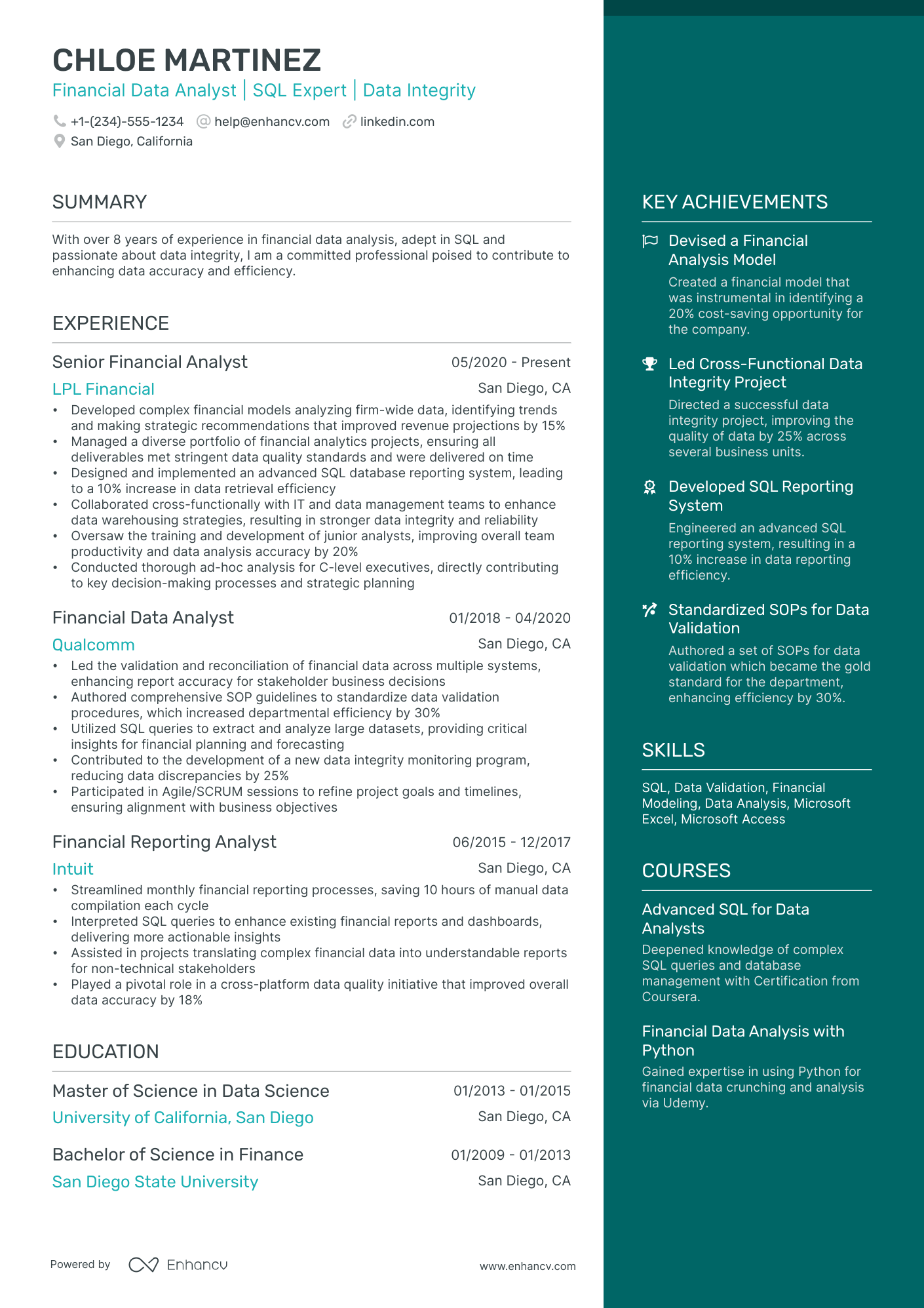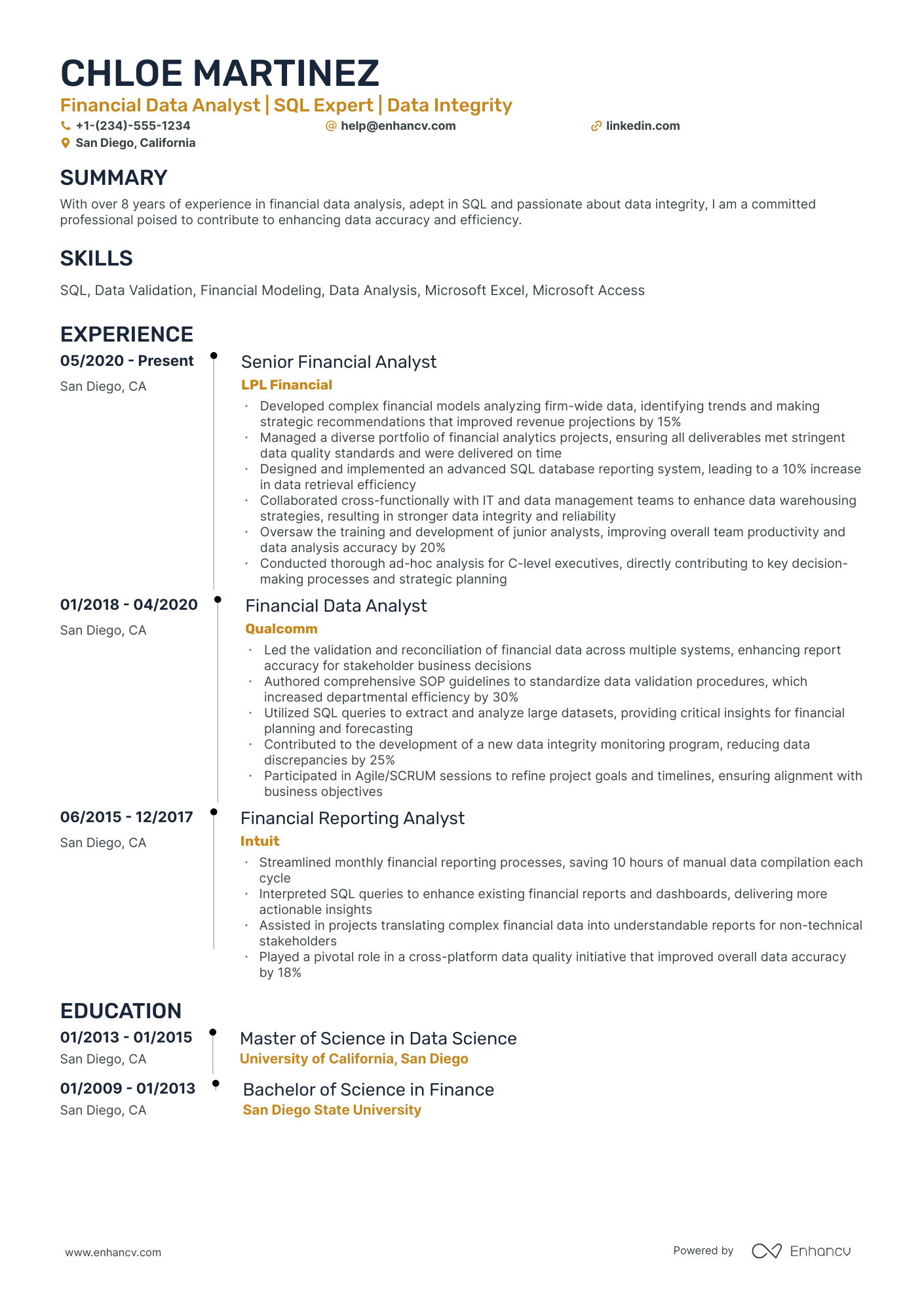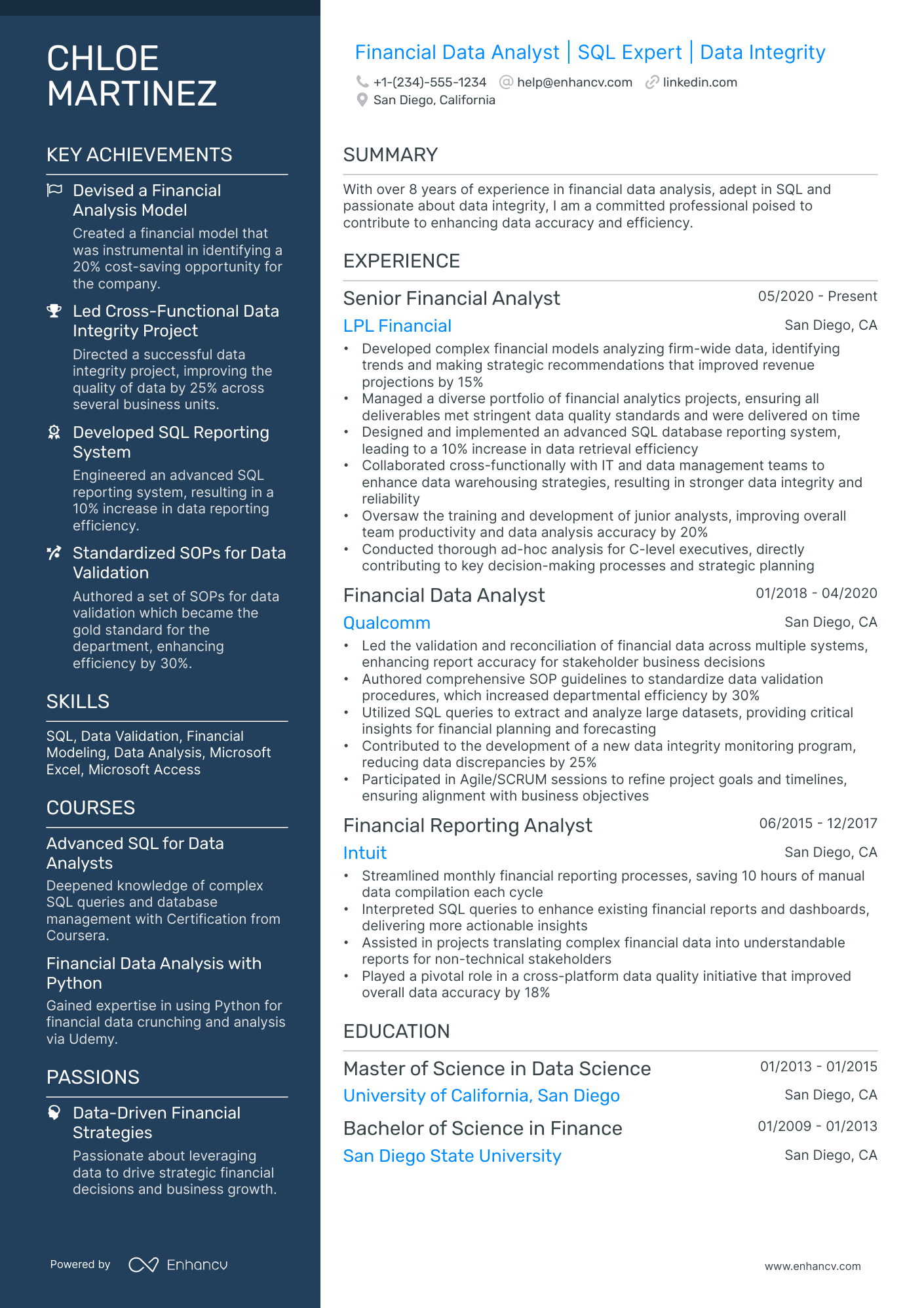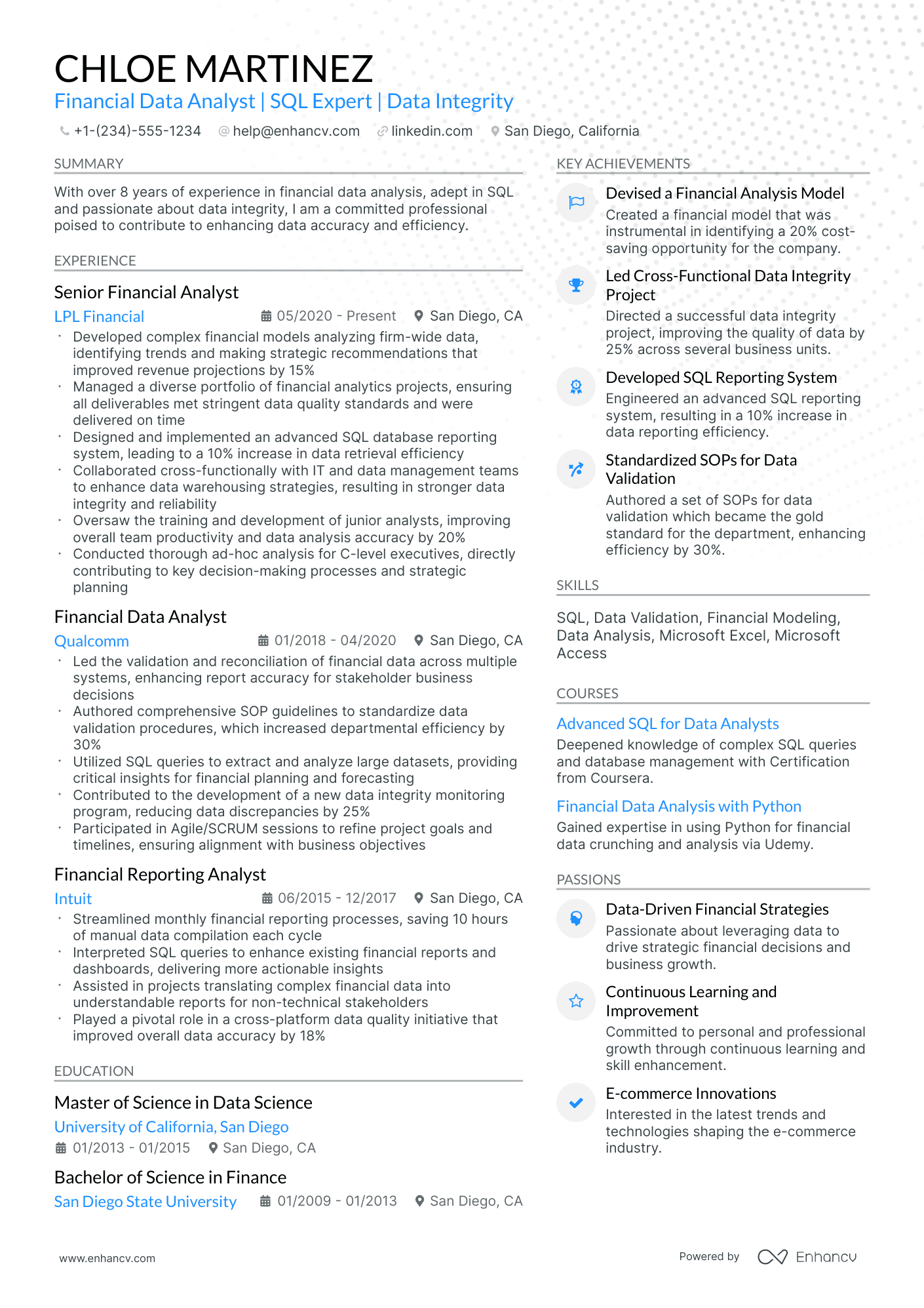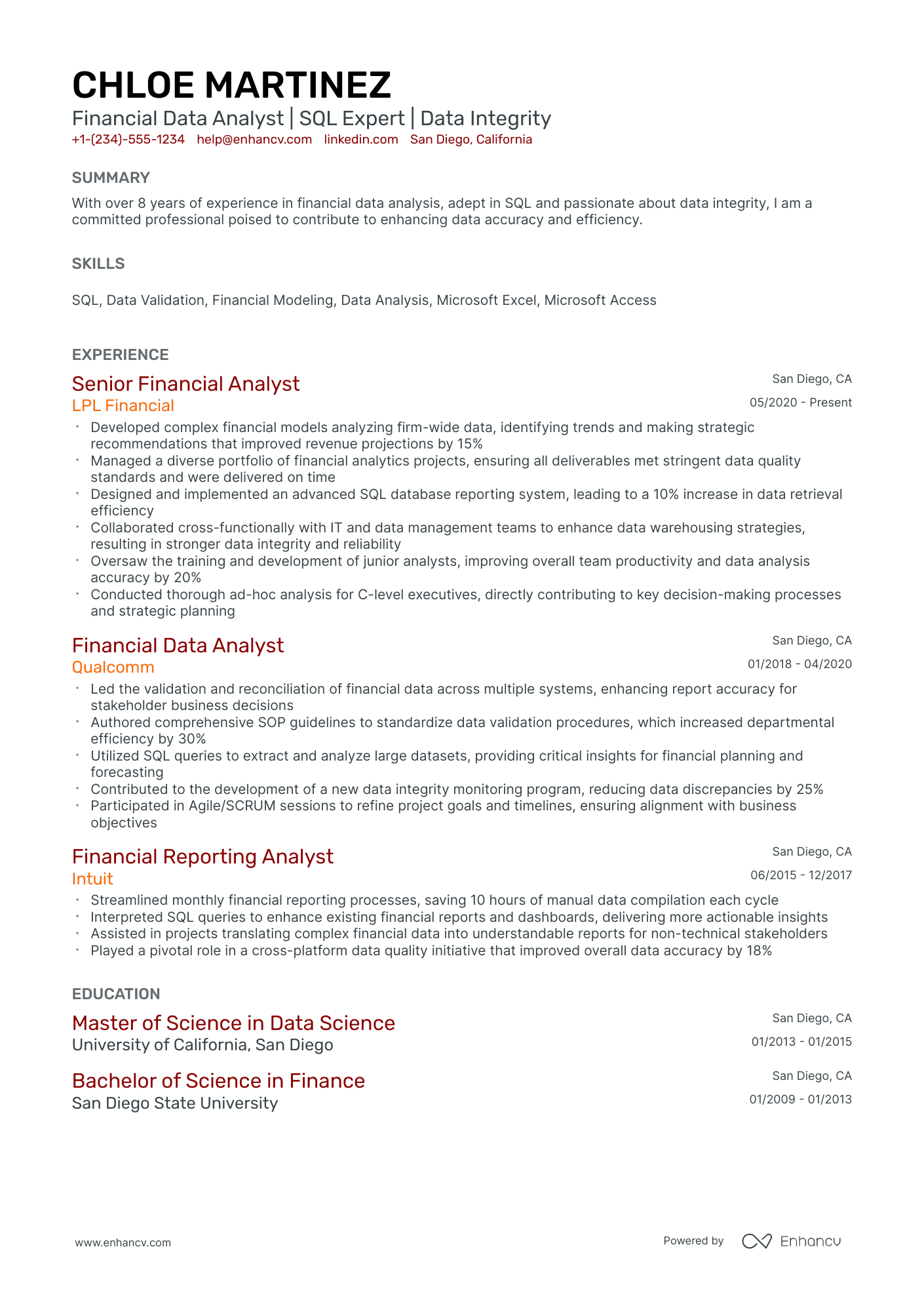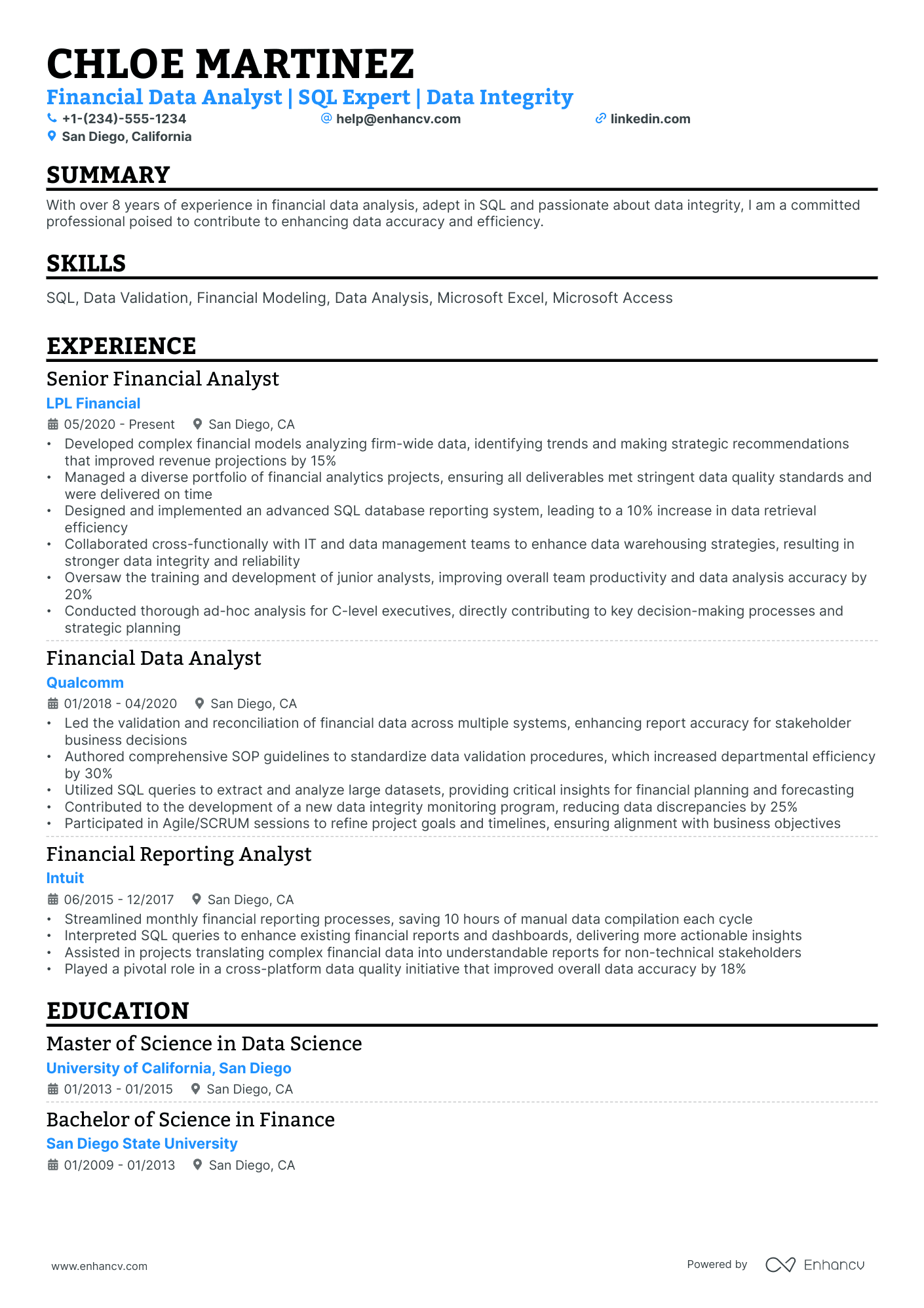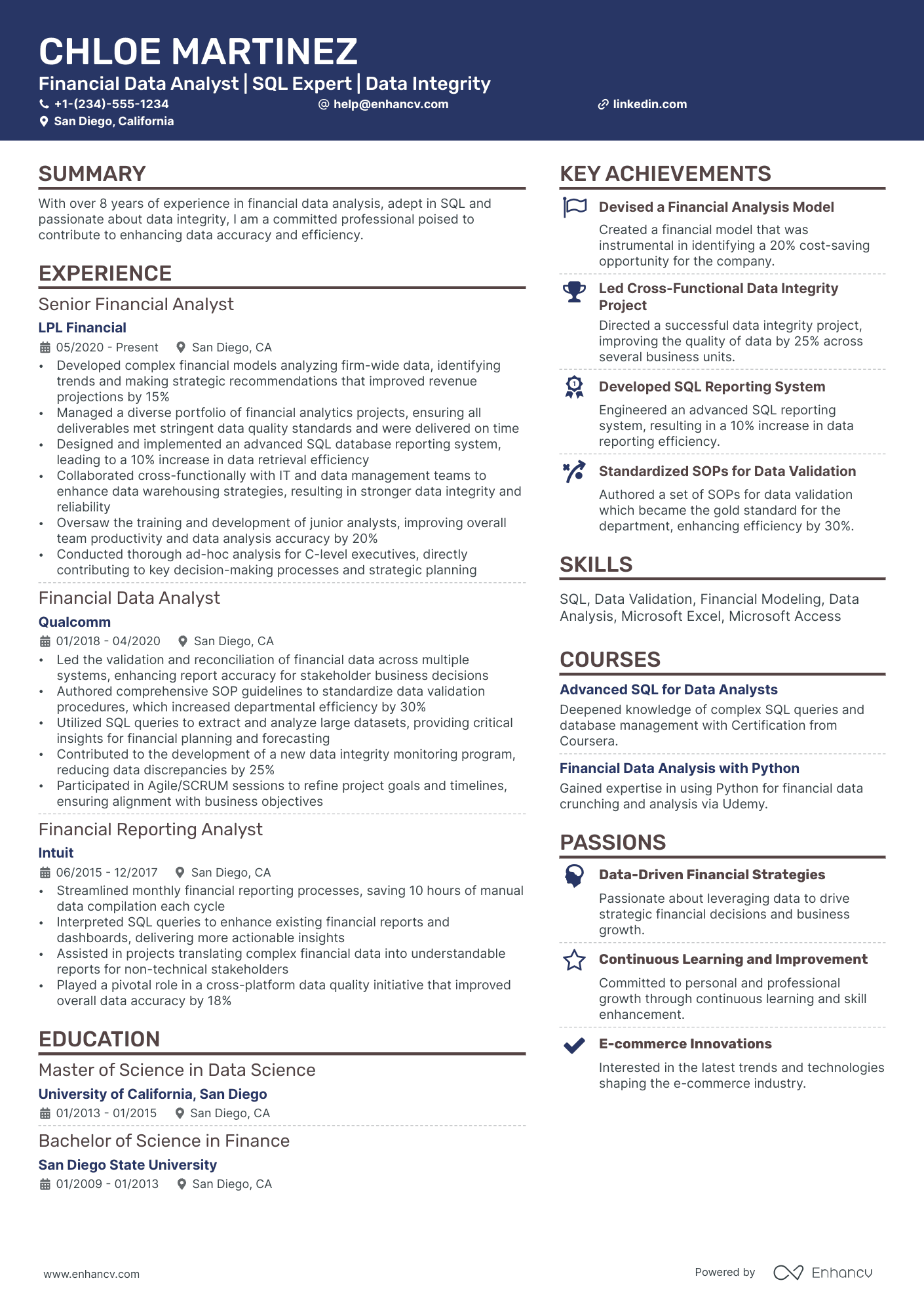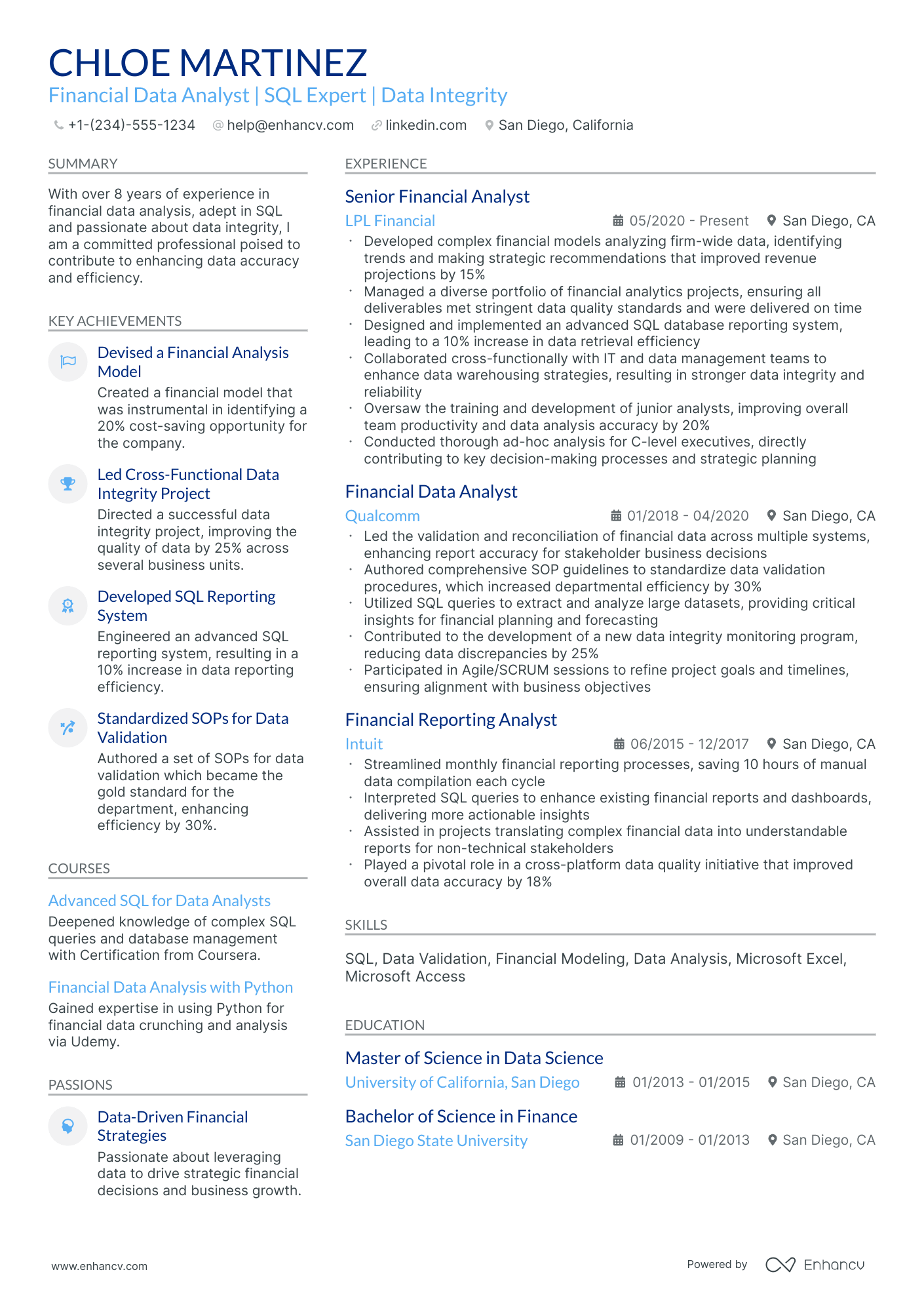As a data quality analyst, articulating your intricate skills in data cleansing and validation on a resume can be challenging due to the technical nature of the job. Our guide offers step-by-step instructions to effectively showcase your expertise in maintaining data integrity, helping you craft a resume that stands out to employers.
- Find different data quality analyst resume examples to serve as inspiration to your professional presentation.
- How to use the summary or objective to highlight your career achievements.
- How to create the experience section to tell your story.
- Must have certificates and what to include in the education section of your resume.
If the data quality analyst resume isn't the right one for you, take a look at other related guides we have:
- Quality Assurance Auditor Resume Example
- Quality Assurance Technician Resume Example
- Quality Control Inspector Resume Example
- Quality Assurance Engineer Resume Example
- Quality Control Technician Resume Example
- Quality Inspector Resume Example
- Test Manager Resume Example
- Supplier Quality Manager Resume Example
- Quality Assurance Analyst Resume Example
- Quality Specialist Resume Example
Creating the best data quality analyst resume format: four simple steps
The most appropriate data quality analyst resume format is defined by precision and a systematic approach. What is more, it should reflect upon how your application will be assessed by recruiters. That is why we've gathered four of the most vital elements to keep in mind when designing your resume:
- It's all about presenting how your experience or skills align with the job. Use the reverse-chronological resume format , if your expertise is relevant to the data quality analyst role. Otherwise, select the functional skill-based resume format or the hybrid resume format to shift the focus to your skill set.
- Resume header - make sure you've filled out all relevant (and correct) information, like your contact details and link to your portfolio.
- Resume length - unless you've over a decade of applicable expertise in the field, stick with a one-page resume format. If you'd like to present more of your professional experience, go up to two pages.
- Resume file - submit your data quality analyst resume in a PDF format to ensure all information stays in the same place.
Be mindful of regional differences in resume formats – a Canadian layout, for instance, might vary.
Upload & Check Your Resume
Drop your resume here or choose a file. PDF & DOCX only. Max 2MB file size.
PRO TIP
List all your relevant higher education degrees within your resume in reverse chronological order (starting with the latest). There are cases when your PhD in a particular field could help you stand apart from other candidates.
Traditional sections, appreciated by recruiters, for your data quality analyst resume:
- Clear and concise header with relevant links and contact details
- Summary or objective with precise snapshot of our career highlights and why you're a suitable candidate for the data quality analyst role
- Experience that goes into the nuts and bolts of your professional qualifications and success
- Skills section(-s) for more in-depth talent-alignment between job keywords and your own profile
- Education and certifications sections to further show your commitment for growth in the specific niche
What recruiters want to see on your resume:
- Proficiency in data quality tools and technologies such as SQL, ETL tools, data profiling, and data cleansing software.
- Experience in developing and implementing data quality metrics, standards, and processes.
- Demonstrable skills in data analysis, problem-solving, and attention to detail in identifying data anomalies and inconsistencies.
- Understanding of data governance principles and experience in collaborating with cross-functional teams on data-related issues.
- Familiarity with data privacy laws and regulations, and ensuring adherence to data compliance standards.
The experience section or the essence of your professional data quality analyst resume
Recruiters always have and always will appreciate well-written data quality analyst resume experience sections.
The experience section is perhaps the most crucial element of your professional presentation, as it needs to answer job requirements while showcasing your technical expertise and personality.
Create your best resume experience section yet by:
- Selecting only relevant experience items to the role you're applying for;
- Always ensure you've listed a metric to quantify your success alongside each experience item;
- Create a narrative that showcases your data quality analyst career succession: this goes to show the time and effort you've invested in the field to build your experience from the ground up;
- Within each experience bullet, consider a problem you've solved, the skills you've used, and the bigger impact this has made in the organization.
Take a look at how other real-life professionals have curated their experience with the data quality analyst samples below:
- Led a team of four analysts to improve data quality across customer databases, achieving a 30% reduction in data errors year-over-year
- Developed and implemented a data governance framework that standardized data entry protocols, enhanced data consistency, and supported regulatory compliance
- Spearheaded the integration of an automated data validation tool that reduced manual checking by 40% and improved overall data reliability
- Evaluated and monitored data quality metrics for a dataset comprising over 1 million customer records, ensuring a 99.5% accuracy rate
- Coordinated with the IT department to troubleshoot and resolve 150+ data anomalies, maintaining alignment with enterprise data management standards
- Initiated a quarterly data quality report that provided insights and recommendations to executive leadership, contributing to informed strategic decision-making
- Performed rigorous data quality audits across various departments, identifying and rectifying discrepancies in sales and marketing data sets
- Collaborated with cross-functional teams to ensure the accurate migration of 500,000+ customer records during a major company-wide system upgrade
- Designed and facilitated data quality training programs for 100+ staff, significantly improving data handling and accuracy across the company
- Enhanced data cleansing procedures which led to a 20% improvement in data usability for business intelligence and analytics initiatives
- Compiled and analyzed complex datasets to assist in the development of a predictive customer behavior model garnering significant marketing insights
- Engaged in a cross-departmental project to establish a centralized customer data repository, facilitating improved data access for all stakeholders
- Directed the design and execution of an enterprise-wide data standardization effort that increased data uniformity across key business segments
- Implemented a sophisticated data-monitoring dashboard that aggregated data quality KPIs, boosting the company's ability to swiftly address data issues
- Orchestrated a successful data clean-up initiative that remediated over 200,000 legacy data items, enhancing the accuracy and utility of historical data
- Executed an organization-wide data fluency program that educated employees on the importance of data hygiene, positively impacting data handling practices
- Oversaw the deployment of a custom data validation engine which automated quality checks for new data sources, resulting in a 25% increase in processing efficiency
- Facilitated the development and maintenance of a centralized metadata management system that improved consistency in reporting and analytics
- Engineered and deployed a suite of data quality measurement tools that provided granular insights, leading to a 15% uptick in data-driven decision accuracy
- Managed and enhanced data ecosystems for e-commerce platforms, bolstering the integrity and dependability of consumer transaction data
- Piloted a successful project to identify and correct 5000+ data inconsistencies in the supply chain management system, ensuring smoother logistic operations
- Championed a comprehensive data cleanup initiative that targeted and resolved data inaccuracies in a high-volume transactional database supporting 10,000+ users daily
- Partnered with data scientists to refine algorithms for data validation, enhancing the detection rate of outliers and anomalous values in complex datasets
- Administered the development of an internal wiki on data standards and procedures, significantly reducing errors in daily data operations
The following content includes information from "O*NET OnLine" by the U.S. Department of Labor, Employment and Training Administration (USDOL/ETA). Used under the CC BY 4.0 license. The data represents the top responsibilities present on the task lists for data quality analyst professionals.
Top Responsibilities for Data Quality Analyst:
- Develop data warehouse process models, including sourcing, loading, transformation, and extraction.
- Verify the structure, accuracy, or quality of warehouse data.
- Map data between source systems, data warehouses, and data marts.
- Develop and implement data extraction procedures from other systems, such as administration, billing, or claims.
- Design and implement warehouse database structures.
- Develop or maintain standards, such as organization, structure, or nomenclature, for the design of data warehouse elements, such as data architectures, models, tools, and databases.
- Provide or coordinate troubleshooting support for data warehouses.
- Write new programs or modify existing programs to meet customer requirements, using current programming languages and technologies.
- Design, implement, or operate comprehensive data warehouse systems to balance optimization of data access with batch loading and resource utilization factors, according to customer requirements.
- Perform system analysis, data analysis or programming, using a variety of computer languages and procedures.
Quantifying impact on your resume
- Specify the number of data sets you have cleaned, standardized, or deduplicated, demonstrating your hands-on experience with data processing.
- Indicate the percentage improvement in data quality you achieved in past projects, showing your ability to enhance data reliability.
- Mention the number of data quality rules or checks you implemented, highlighting your proactive approach to maintaining data integrity.
- Quantify the scale of databases or data warehouses you managed, reflecting your capacity to handle large volumes of data.
- Report the decrease in data-related errors discovered post-implementation of your quality assurance methods, illustrating the tangible impact of your work.
- Note any increase in efficiency, such as reduced data processing time, due to your optimization efforts, showcasing productivity gains.
- Detail the number of cross-functional teams you collaborated with, underlining your interpersonal skills and teamwork in data-related tasks.
- Record the amount of training sessions you conducted or the number of staff you mentored on data quality practices, establishing your leadership and expertise.
Action verbs for your data quality analyst resume
How to shift the focus from your data quality analyst resume experience section to your professional profile
If you're at the start of your career journey or transitioning industries, you might be concerned about the lack of professional experience while crafting your data quality analyst resume.
How can you effectively present your data quality analyst resume experience section under these circumstances?
Rather than a traditional, extensive experience section, demonstrate your expertise through:
- Emphasizing your education. Your academic background might impress recruiters, especially if it includes recent, industry-relevant knowledge;
- Creating a compelling objective statement. The first few sentences of your resume should map out your motivations and career aspirations, offering insight into your goals;
- Highlighting your transferable skills. For example, if you've honed communication skills through volunteering, illustrate on your data quality analyst resume how these can benefit a potential employer;
- Detailing your technical background in certifications and skills sections. As a recent graduate, your technological foundations might be particularly attractive to employers looking to develop these skills further.
It's important to remember that employers sometimes prefer candidates with less experience but who are a better cultural fit for their organization.
Recommended reads:
PRO TIP
Always remember that your data quality analyst certifications can be quantified across different resume sections, like your experience, summary, or objective. For example, you could include concise details within the expertise bullets of how the specific certificate has improved your on-the-job performance.
Popular data quality analyst hard skills and soft skills for your resume
Apart from assessing your professional expertise, recruiters are on the lookout for whether your skills align with the job.
Your profile would thus be assessed in regard to your:
- Hard or technical skills - your ability to perform on the job using particular technologies or software
- Soft skills - how you adapt, communicate, and thrive in different environments.
Both types of skills - hard and soft skills - are important for your resume, so make sure to create a dedicated skills section that:
- Lists up to five or six skills that align with the job advert.
- Integrates vital keywords for the industry, but also reflects on your personal strengths.
- Builds up further your skills with an achievements section within which you explain what you've achieved thanks to using the particular skill.
- Aims to always quantify in some way how you've used the skill, as it's not enough to just list it.
What are the most sought out hard and soft skills for data quality analyst roles?
Check out the industry's top choices with our two dedicated lists below:
Top skills for your data quality analyst resume:
SQL
Python
R
Data Profiling Tools
Data Visualization Tools (e.g., Tableau, Power BI)
ETL Tools (e.g., Talend, Informatica)
Data Quality Tools (e.g., Talend Data Quality, Informatica Data Quality)
Excel
Database Management Systems (e.g., MySQL, PostgreSQL)
Statistical Analysis Software
Analytical Thinking
Attention to Detail
Problem-Solving
Communication Skills
Team Collaboration
Time Management
Adaptability
Critical Thinking
Organizational Skills
Project Management
Next, you will find information on the top technologies for data quality analyst professonals from "O*NET OnLine" by the U.S. Department of Labor, Employment and Training Administration (USDOL/ETA). Used under the CC BY 4.0 license.
Top technologies for Data Quality Analyst’s resume:
- Amazon DynamoDB
- Oracle PL/SQL
- Microsoft PowerPoint
- Informatica software
- Quest Erwin Data Modeler
PRO TIP
List all your relevant higher education degrees within your resume in reverse chronological order (starting with the latest). There are cases when your PhD in a particular field could help you stand apart from other candidates.
How to include your education and certifications on your resume
We're taking you back to your college days with this part of our guide, but including your relevant higher education is quite important for your resume.
Your degree shows recruiters your dedication to the industry, your recent and relevant know-how, and some form of experience in the field.
Your data quality analyst resume education should:
- Include your applicable degrees, college (-s) you've graduated from, as well as start and end dates of your higher education;
- Skip your high school diploma. If you still haven't graduated with your degree, list that your higher education isongoing;
- Feature any postgraduate diplomas in your resume header or summary - this is the perfect space to spotlight your relevant MBA degree;
- Showcase any relevant coursework, if you happen to have less professional experience and think this would support your case in being the best candidate for the role.
As far as your job-specific certificates are concerned - choose up to several of the most recent ones that match the job profile, and include them in a dedicated section.
We've saved you some time by selecting the most prominent industry certificates below.
The top 5 certifications for your data quality analyst resume:
- Certified Data Management Professional (CDMP) - DAMA International
- IBM Certified Data Architect - Big Data (IBM CDABD) - IBM Professional Certification Program
- Informatica Certified Professional (ICP) - Informatica
- Microsoft Certified: Data Analyst Associate (MCDA) - Microsoft
- SAS Certified Data Scientist (SCDS) - SAS Institute Inc.
The content below includes information from "O*NET OnLine" by the U.S. Department of Labor, Employment and Training Administration (USDOL/ETA). Used under the CC BY 4.0 license. The data represents the top associations for data quality analyst professionals.
Top US associations for a Data Quality Analyst professional
- Higher Education Data Warehousing
- Association for Computing Machinery
- Association for Information Science and Technology
- Association for Information Systems
- Association for the Advancement of Artificial Intelligence
PRO TIP
Always remember that your data quality analyst certifications can be quantified across different resume sections, like your experience, summary, or objective. For example, you could include concise details within the expertise bullets of how the specific certificate has improved your on-the-job performance.
Recommended reads:
Adding a summary or objective to your data quality analyst resume
One of the most crucial elements of your professional presentation is your resume's top one-third. This most often includes:
- Either a resume summary - your career highlights at a glance. Select the summary if you have plenty of relevant experience (and achievements), you'd like recruiters to remember about your application.
- Or, a resume objective - to showcase your determination for growth. The perfect choice for candidates with less experience, who are looking to grow their career in the field.
If you want to go above and beyond with your data quality analyst resume summary or resume objective, make sure to answer precisely why recruiters need to hire you. What is the additional value you'd provide to the company or organization? Now here are examples from real-life data quality analyst professionals, whose resumes have helped them land their dream jobs:
Resume summaries for a data quality analyst job
- With over 8 years of comprehensive experience in data analysis and quality assurance, adept in SQL, Python, and Tableau, I have successfully led a data cleanup initiative resulting in a 30% increase in data accuracy for a multinational retail giant. My strong analytical skills and attention to detail stand out in maintaining high standards of data integrity.
- Former financial analyst with 5 years of experience in data-driven decision-making and possesses advanced skills in Excel, R, and statistical analysis. Transitioning into a data quality analyst role after implementing a robust financial data validation system that reduced quarterly errors by 40%, eager to apply analytical acumen to ensure impeccable data quality.
- Seasoned software developer making a strategic shift to data quality analysis, bringing forth 6 years of experience in coding, database management, and a keen understanding of machine learning algorithms. My crowning achievement includes the deployment of an error-detection algorithm that reduced data discrepancies by 35% in a tech startup environment.
- Passionate about harnessing the power of data to drive business success, I am keen to bring my recent data science certification and a fresh perspective to a data quality analyst role. With strong foundations in Python, SQL, and data visualization, I am ready to contribute to continuous improvement processes and uphold the highest data standards.
- As a recent graduate with a Master’s in Data Analytics and internships involving data management and cleansing, my objective is to apply my theoretical knowledge and hands-on experience to ensuring the quality and reliability of large datasets. I am eager to develop my expertise in a dynamic environment while making a tangible impact through meticulous data validation.
- With a profound interest in data science and firm roots in computer engineering, I am looking for an opportunity to employ my strong analytical and problem-solving skills as a data quality analyst. Although new to the field, I am committed to learning and excelling in data quality methodologies and aspire to be a catalyst for data excellence within an innovative organization.
Optimize your resume summary and objective for ATS
Drop your resume here or choose a file.
PDF & DOCX only. Max 2MB file size.
Average salary info by state in the US for data quality analyst professionals
Local salary info for Data Quality Analyst.” Source: My Next Move, National Center for O*NET Development. Accessed 10/15/2024
| State | Average Salary (in USD) |
|---|---|
| US National Average | $134,700 |
| California (CA) | $162,250 |
| Texas (TX) | $138,090 |
| Florida (FL) | $123,960 |
| New York (NY) | $142,230 |
| Pennsylvania (PA) | $125,790 |
| Illinois (IL) | $128,990 |
| Ohio (OH) | $127,230 |
| Georgia (GA) | $155,210 |
| North Carolina (NC) | $125,860 |
| Michigan (MI) | $122,700 |
Miscellaneous data quality analyst resume sections for a more personalized approach
Your data quality analyst resume can reflect even more upon your personality and best qualities - that is if you decide on including a couple of additional resume sections to support your application.
Some of the best-accepted industry-wide choices include the:
- Resume projects - getting into the outcomes of your most important work, so far;
- Languages on your resume - detailing your proficiency level;
- Special recognitions - dedicated to your most prominent industry awards;
- Hobbies and interests - defining how you spend your free time.
Key takeaways
- Pay special attention to the tiny details that make up your data quality analyst resume formatting: the more tailored your application to the role is, the better your chances at success would be;
- Select the sections you include (summary or objective, etc.) and formatting (reverse-chronological, hybrid, etc.) based on your experience level;
- Select experience items and, consequently, achievements that showcase you in the best light and are relevant to the job;
- Your profile will be assessed both based on your technical capabilities and personality skills - curate those through your resume;
- Certifications and education showcase your dedication to the particular industry.
